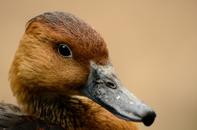
Name
Fulvous duck - Dendrocygna bicolour
Fulvous Duck Appearance
The fulvous duck is around 46 cm in length. This duck has a grey bill and grey legs. The head and underparts are golden brown in colour, with a darker, almost grey, back and wings. The patches on the tail and wings are rufous in colour. Both sexes are similar.
Diet
The fulvous duck feeds mainly on aquatic plants, but will also feed on aquatic insects.
Fulvous Duck Breeding
Breeding in South Africa takes place between December to February. Fulvous ducks are monogamous. Both sexes build the nest out of leaves and plant stems, well concealed in long grass or dense vegetation, close to water. Up to ten eggs are laid, but up to 20 eggs been recorded in a single nest. Both parents incubate the eggs for around 28 days. The chicks are precocial and leave the nest after around 24 hours. The chicks fledge at 9 weeks.
Fulvous Duck Behaviour
The fulvous duck is gregarious during the non-breeding season. This is a noisy duck with a distinct whistling call, which is made both on the ground and in flight.
Threats
None – common across its range.
Fulvous Duck Distribution and Habitat
Fulvous ducks are found on inland bodies of water, that have abundant aquatic vegetation. They are distributed across the northeast region of South Africa.